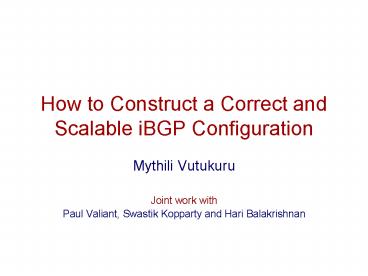How to Construct a Correct and Scalable iBGP Configuration - PowerPoint PPT Presentation
1 / 23
Title:
How to Construct a Correct and Scalable iBGP Configuration
Description:
New approach ('BGPSep') to configure iBGP that is both correct and scalable ... Local Pref. AS path length. MED. IGP cost to egress ... – PowerPoint PPT presentation
Number of Views:45
Avg rating:3.0/5.0
Title: How to Construct a Correct and Scalable iBGP Configuration
1
How to Construct a Correct and Scalable iBGP
Configuration
- Mythili Vutukuru
- Joint work with
- Paul Valiant, Swastik Kopparty and Hari
Balakrishnan
2
BGP
eBGP and iBGP
18.0.0.0/8
eBGP
iBGP
Border router/ Egress
Autonomous System (AS)
Route
3
Our contribution
- Status quo in configuring iBGP
- Full-mesh (not scalable)
- Route reflection (no correctness guarantees)
- New approach (BGPSep) to configure iBGP that is
both correct and scalable - Uses the results on graph separators from graph
theory
4
Outline of the talk
- More background
- What is the status quo?
- What are the problems with it?
- Problem statement
- Our solution
5
Background - iBGP
18.0.0.0/8
- iBGP sessions run on TCP
- Overlay over the intra-domain routing protocol or
Interior Gateway Protocol (IGP) like OSPF - Routing messages and data packets forwarded via
IGP within AS - iBGP Rule to avoid routing loops
- Routes from iBGP session not propagated to
another iBGP session
iBGP
IGP
Route
6
Approach1 Full-mesh iBGP
18.0.0.0/8
B
A
D
- Every router has an iBGP session to every border
router - Large number of iBGP sessions not scalable
C
iBGP session
Route
7
Scalable alternative Route reflection
Route reflector
B
18.0.0.0/8
A
- Reflects routes to and from client iBGP
sessions - Avoids full-mesh
- Hierarchy of reflectors
D
C
Client iBGP session
Route
8
Problems with route reflection 1
- Problem 1 Routers may not choose best route
- Why? Route reflector reflects only its best route
B
A
18.0.0.0/8
Client session
D
Route
Data packets
C
- B chooses the sub-optimal route through C
- In full-mesh B would have chosen route through A
- Sub-optimal path assignments
Lower cost to egress
9
Problem2 Forwarding loops
18.0.0.0/8 goto A
To 18.0.0.1
IGP
To 18.0.0.1
Client iBGP session
Route
18.0.0.0/8 goto D
IGP link
Data packets
10
Background - Summary
iBGP configuration Correctness Scalability
Full-mesh v
Route reflection v
We need v v
11
Outline of the talk
- More background
- What is the status quo?
- What are the problems with it?
- Problem statement
- Our solution
12
Problem Statement
- Input IGP (IP-level connectivity) graph
- Output iBGP configuration
- Route reflectors and clients
- iBGP sessions
- Constraints
- Emulate full-mesh
- More scalable than full-mesh
- Previous work GW02 how to check for
correctness, not how to construct correct
configurations - GW02 T. Griffin and G. Wilfong, On the
Correctness of iBGP Configuration, In Proc. ACM
SIGCOMM 2002, Pittsburg, PA, August 2002.
13
Outline of the talk
- More background
- What is the status quo?
- What are the problems with it?
- Problem statement
- Our solution
14
Key insight for emulating full-mesh
- For every BGP router P, every egress E
- P and E have iBGP session, OR
- P should be the client of a route reflector on
the shortest path between P and E
A
R
C
18.0.0.0/8
B
18.0.0.0/8
15
Our solution BGPSep
18/8
S
- S is graph separator
- Nodes in graph separator S are route reflectors
- u in G1 or G2, v in S u is a client of v
- Full-mesh in G1, G2 !!!
- Recurse on G1, G2
- Recursion terminates when component small enough
D
A
?
B
G2
G1
18/8
16
Evaluation
- 2.5 to 5X fewer iBGP sessions on ISP topologies
Source Rocketfuel
17
Features of BGPSep
- Efficient implementation
- 100 lines of Matlab
- Runs in a few seconds
- Convenient to use
- Need not be re-run when link costs change or
nodes/links fail - Small number of top-level route reflectors
- Not incremental need to be re-run when
nodes/links added
18
Conclusion
- First algorithm to construct correct iBGP
configurations with route reflection. - Reduces iBGP sessions compared to full-mesh
- Efficient implementation
- Convenient and practical to use
- Questions?
19
Questions?
20
Best route selection
- BGP best route selection rules
- Local Pref
- AS path length
- MED
- IGP cost to egress
- Best route selected by route reflector might not
be the best route for the client
21
Route reflection
- 2 types of iBGP sessions
- Client iBGP session
- Normal (peer) iBGP session
- Route from client ? all clients and peers
- Route from peer ? all clients
- Multiple route reflectors
- Hierarchy of route reflectors
22
Problems with route reflection
- Lack of complete visibility every router is not
guaranteed to see its best available route. - Forwarding loops
- Some router along the forwarding path chooses a
different egress - Packets do not make progress towards egress and
loop forever - Not robust to IGP changes
- IGP link failures trigger forwarding loops
- Full-mesh iBGP has none of these problems
23
Key insight for emulating full-mesh
- For every router P, every egress E
- P and E have iBGP session, OR
- P should be the client of a route reflector on
the shortest path between P and E
To R
R goto D
R
R
To R
To R
Client iBGP session
Route
R goto A
IGP link
Data packets

